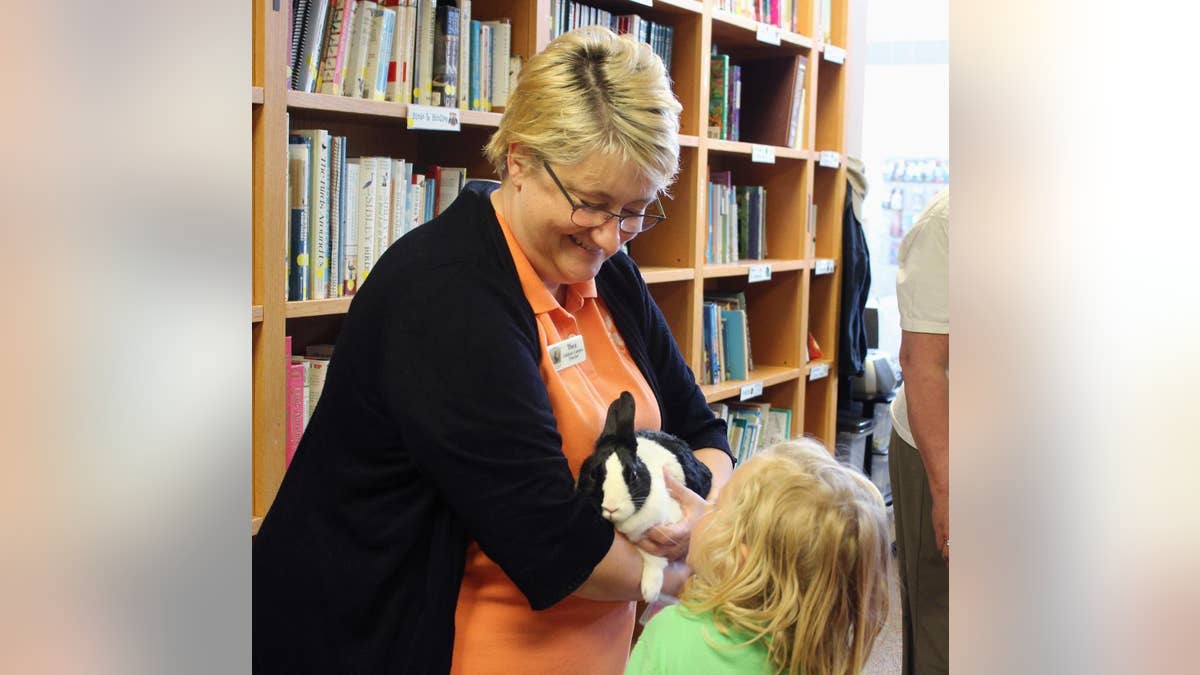
In this May 25, 2016, photo, South Dakota wildlife official Thea Miller, the director of the Outdoor Campus in Sioux Falls, S.D., holds a rabbit while children pet it and listen to her talk about the need to avoid rescuing healthy baby wild animals. Miller has started a social media campaign to remind people to leave baby wild animals alone. (AP Photo/Regina Garcia Cano) (The Associated Press)
SIOUX FALLS, S.D. – A South Dakota wildlife official is trying to combat a scene she sees several times every summer: A mom and her children show up carrying a box with holes poked in the top and a baby wild animal inside.
The family thinks they've rescued it from apparent abandonment, but that's far from the truth, Thea Miller Ryan says, because the rescue can be harmful, even deadly. So, with the backdrop of the bison calf in Yellowstone that had to be euthanized this month after tourists put it in their car, Ryan is taking to social media to teach people to let nature take its course.
"I know that it's not going to have a happy ending," Miller said of any rescued animal's future. "... Really, the minute humans intervene with wildlife in most cases, not all, it's a death sentence."
Miller and the Outdoor Campus in Sioux Falls, which she directs, have been teaching adults and children for years to avoid this type of rescues. But the number of calls the facility receives every year — upward of 300 — has not decreased. Now, for every call her office answers about a potential rescue, she posts on Facebook and Twitter a photo of a ceramic sparrow that has a sugar skull as its head. The accompanying message mentions the creature that the call was about and the phrase, "If you care, leave it there."
Her campaign comes at an appropriate time after the failed "rescue" at Yellowstone National Park, where a man told park rangers that he loaded a bison calf into his sport utility vehicle May 9 because he thought it was cold. Rangers took the animal back to where it was picked up, but they could not reunite it with the herd. The calf had to be euthanized as it was causing a dangerous situation by constantly approaching people and cars.
"You wouldn't pick up your neighbor's kid and try to raise it just on your own. So, why would you assume that you want no better than mother nature?" said Kenneth Wilson, who leads the fish, wildlife and conservation biology department at Colorado State University. "... How do we know they are abandoned? They have no sign on them."
Wildlife officials across the country almost always encourage people who have attempted a rescue to return the animals exactly where they found them, because mothers are likely to return to their offspring after searching for food or hiding from predators. People are also told to put the animals in a nearby area if they are at risk of being attacked by a pet. The Wisconsin Department of Natural Resources, for example, has a website that helps people determine whether a wild animal is orphaned and provides detailed descriptions for at least 13 species.
People are also encouraged to use gloves while handling the animals and avoid hugging them to prevent their "human scent" from transferring, which could be a giveaway to predators.
"Nature can be pretty darn harsh," Wilson said. "Often sometimes people will grab a youngster, 'Oh, we are worried about it getting attacked by something,' Well, that's the natural cycle."
___
Reach Regina Garcia Cano on Twitter at: https://www.twitter.com/reginagarciakNO

